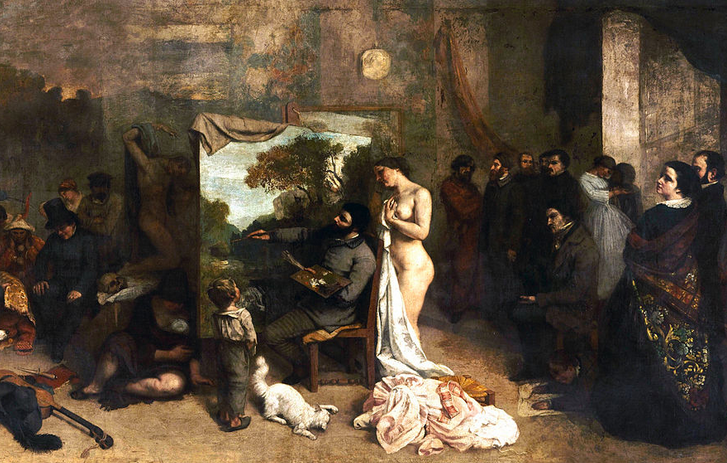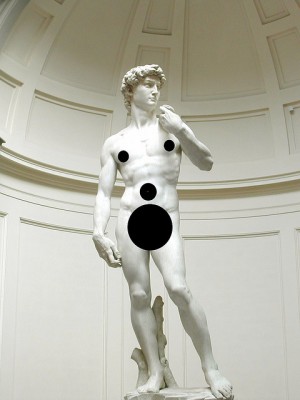
Gustave Courbet's “The Painter's Studio”. Public domain.
Are there limitations to the type of art we're willing to publish on Global Voices? As the primary steward of our mission to promote and protect free expression online, my default answer is yes. Of course, we are careful when it comes to publishing images that depict extreme graphic violence. We do not publish images that clearly represent pornography. And like many media organizations, we have special restrictions when it comes to publishing images of children. When I think about all this, the “yes” from the top of this paragraph starts to sound more like a “yes, but…”
Two weeks ago, in reviewing two separate posts dealing with the subject of nudity and censorship on Facebook, I found myself exploring the various shades of grey that lie between what images are definitely appropriate for GV and what images are not.
One involved a professor in France who had his Facebook account suspended after he posted an image of French impressionist Gustave Courbet's “The Origin of the World”. The classic, well-known oil painting depicts the lower torso and pelvis of a naked woman lying on a bed. Her legs are spread apart, leaving her vagina in plain view, unquestionably the intended focus of the piece.
Another focused on Venezuelan contemporary artist Erika Ordosgoitti who had her page taken down after she posted photos from a recent collection of her artwork. Although the images were not sexual in nature and to my eye, showed clear artistic intent, Ordosglotti indeed was naked in several of them. Facebook seemed to think these were not okay.
Both posts in question condemned Facebook for blocking art images that showed naked women's bodies. So we had to make a decision. Were we comfortable publishing these images on our site?
In both cases, I felt inclined to publish some of the images that had caused the pages to be removed — these were simply artworks depicting women's bodies. No sign of abuse, no suggestion of pornographic intent. But still naked bodies. I knew that this kind of issue is deeply informed by personal and cultural experience — coming from a progressive, no-nonsense feminist family in the US, I could hardly cast my own sensibilities as representative of the entire GV community. I took a quick poll among GVers who I could find on chat and found that while I wasn't alone in my personal inclination, there were plenty of others who felt differently.
As Jeremy has a long memory for things like this, I asked if he knew what standards we'd used to make these kinds of decisions in the past. We started out by looking at the wiki (it is useful sometimes!). GV has a “graphic content” policy, but it was written with graphic violence in mind. Sexually explicit non-violent imagery falls into another category, and we agreed that we should not treat it the same way. While readers might be uncomfortable looking at sexually explicit images, the reasons we might limit displaying this on the site would be very different from the reasons we would refrain from showing depictions of violence. While we can usually confirm that an artist had the permission to show his or her subject in the nude, the depiction of violent acts implies no such element of consent.
We agreed that we needed to consider building a standard for this type of imagery. From there, Jeremy, Georgia, Gohary, Lauren and I identified a few options to pose for the community.
1. Let it be — and consider adding a warning.
We could show the image at the top of the post and bear the consequences, including possible suspension of our Facebook account. My more deviant side wanted to try this, just to see what would happen, but this is not my own personal blog — GV belongs to a community that deserves to have input in decisions like this.
We could alter this approach by including the image beneath the “fold” of the post and add a warning at the top of the page, so that readers could decide whether or not they wanted to scroll down. But this could put readers in an uncomfortable and compromised position, and could discourage them from reading the full story.
2. Hide the “graphic” bits.
We could blur or black out the most explicit part of the painting, but this would have left us with little to look at, in this particular case. I am not keen on this option as it feels more censorious than any of the others — we'd actually be creating a new image altogether, a crude interference with the artist's original work. To the right is one example I found online. Not very nice to look at.
3. Leave the image off the site.
We could link to the image, as I've done with Origin of the World, and let readers decide whether or not to visit an outside page.
4. Let the reader decide
We could build a simple feature that would allow us to hide an image, using a dark, screen-like effect, and including the words “click to view”. This way, the reader could choose to see the photo with just one click, or opt not to.
Georgia and I looked back on threads from the past where we found some useful clues. A 2007 conversation between Portnoy and Haitham resulted in some degree of consensus about including what is known as a “trigger warning” (similar to the idea in option #1) — for certain types of images, we'd give readers a warning before presenting them with an image. At the time, the only clear way to do this was to include some warning text and a link where readers could click if they wanted to see the image in question. But the screen option could offer us a more streamlined way of doing this.
How do we decide which images are “graphic”?
There are many other questions still unanswered here. How do we decide which images get special treatment, and which ones simply stand as they are? When you look at the many different artworks online that depict nude bodies, there are so many details that suddenly seem relevant to the issue — the position of the body, interaction with other bodies, color, lighting, and infinite other factors seem to embedded in the question of what counts as a “graphic” image. In the case of the Courbet painting, time seems to have a role too — when a work is “classic” or simply old, it is often considered less graphic than something contemporary.
It is also impossible to divorce this decision from personal feeling and choice — I imagine that this is part of the reason that it is so difficult for social media platforms to determine what stays and what goes when it comes to images like these.

Vagina cupcakes by Philippa Willitts; cartoon by Gustavo Garrincha.
The kinds of images we're talking about here are not always serious, either — my image searches for this post revealed that vagina-shaped cupcakes have become a popular snack at baby showers in the US. I also revisited Garrincha, the Cuban-American comic artist whose characters are often represented by semi-erect penises. Since these are clearly in jest and a far cry from actual graphic representations of human reproductive organs, I decided to include them here.
In the interest of moving forward on this post, I decided to honor the process by including a different, less sexually explicit Courbet image (see top) and linking out to Origin of the World. I chose this particular alternative because it depicts the artist's process and we can assume that the nude woman standing by his side is or was a subject for another painting. All of this seemed germane to the issues in question.
But the bigger question remains, and we need to discuss it as a community. How should we tackle this question? Is the “curtain” tool a good idea? If so, what belongs behind it? GVers, have at it!





2 comments